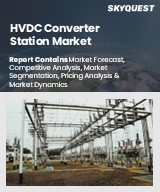
|
시장보고서
상품코드
1796425
HVDC 컨버터 스테이션 시장 규모, 점유율, 성장 분석 : 컨버터 유형별, 컴포넌트별, 기술별, 용도별, 최종사용자별, 지역별 - 산업 예측(2025-2032년)HVDC Converter Station Market Size, Share, and Growth Analysis, By Converter Type (Line Commutated Converters (LCC), Voltage Source Converters (VSC)), By Component, By Technology, By Application, By End User, By Region - Industry Forecast 2025-2032 |
||||||
세계의 HVDC 컨버터 스테이션 시장 규모는 2023년에 128억 2,000만 달러로 평가되며, 2024년 141억 6,000만 달러에서 2032년에는 317억 3,000만 달러로 성장하며, 예측 기간(2025-2032년)의 CAGR은 10.50%로 성장할 전망입니다.
세계 HVDC 컨버터 스테이션 시장은 재생에너지원의 통합, 송전망의 현대화, 지속적인 기술 혁신으로 인해 크게 성장하고 있습니다. 정부와 전력회사는 장거리 송전을 효율화하고 송전망의 안정성을 높이기 위해 HVDC 기술을 활용한 강력한 송전 인프라 개발에 점점 더 우선순위를 두고 있습니다. 대규모 프로젝트는 멀리 떨어진 재생에너지 발전소와 대규모 소비지 간의 연결을 용이하게 하고, 수요와 실시간 상황에 기반한 역동적인 전력 흐름 관리를 가능하게 합니다. 또한 머신러닝과 인공지능의 발전은 전력 관리 방식을 변화시켜 초효율적인 그리드 제어와 예지보전을 가능하게 하고 있습니다. 그 결과, 이 산업은 신뢰할 수 있는 에너지 솔루션에 대한 수요 증가에 대응하고 재생 자원을 에너지 믹스에 원활하게 통합하기 위해 빠르게 발전하고 있습니다.
목차
서론
- 분석 목적
- 시장 범위
- 정의
분석 방법
- 정보 조달
- 2차·1차 데이터 방법
- 시장 규모 예측
- 시장 상정과 제약
개요
- 시장 개요와 전망
- 수급 동향 분석
- 부문별 기회 분석
시장 역학과 전망
- 시장 개요
- 시장 규모
- 시장 역학
- 촉진요인과 기회
- 억제요인과 과제
- Porter의 산업 분석
시장의 주요 인사이트
- 주요 성공 요인
- 경쟁의 정도
- 주요 투자 기회
- 시장 에코시스템
- 시장의 매력 지수(2024년)
- PESTEL 분석
- 거시경제 지표
- 밸류체인 분석
- 가격 분석
- 기술 분석
- 사례 연구
세계의 HVDC 컨버터 스테이션 시장 규모·CAGR : 컨버터 유형별(2025-2032년)
- 시장 개요
- LCC(Line Commutated Converters)
- 전압원 컨버터(VSC)
세계의 HVDC 컨버터 스테이션 시장 규모·CAGR : 컴포넌트별(2025-2032년)
- 시장 개요
- 컨버터 트랜스
- 평활화 리액터
- 밸브
- 제어·보호 시스템
- 기타
세계의 HVDC 컨버터 스테이션 시장 규모·CAGR : 기술별(2025-2032년)
- 시장 개요
- 모노폴라
- 바이폴라
- 연속식
세계의 HVDC 컨버터 스테이션 시장 규모·CAGR : 용도별(2025-2032년)
- 시장 개요
- 대규모 송전
- 전력망 상호연결
- 도시용 이송(인피드)
세계의 HVDC 컨버터 스테이션 시장 규모·CAGR : 최종사용자별(2025-2032년)
- 시장 개요
- 유틸리티
- 재생에너지 발전기
- 산업 부문
세계의 HVDC 컨버터 스테이션 시장 규모·CAGR(2025-2032년)
- 북미
- 미국
- 캐나다
- 유럽
- 독일
- 스페인
- 프랑스
- 영국
- 이탈리아
- 기타 유럽
- 아시아태평양
- 중국
- 인도
- 일본
- 한국
- 기타 아시아태평양
- 라틴아메리카
- 브라질
- 기타 라틴아메리카
- 중동 및 아프리카
- GCC 국가
- 남아프리카공화국
- 기타 중동 및 아프리카
경쟁 구도
- 상위 5사의 비교
- 주요 기업의 시장 포지셔닝(2024년)
- 주요 기업이 채택한 전략
- 시장의 최근 동향
- 주요 기업의 시장 점유율(2024년)
- 주요 기업의 개요
- 기업 개요
- 제품 포트폴리오 분석
- 부문별 점유율 분석
- 매출의 전년대비 비교(2022-2024년)
주요 기업 개요
- General Electric
- Siemens
- Mitsubishi Electric Corporation
- NR Electric Co.
- Toshiba Corporation
- Hyosung Heavy Industries Corporation
- Hitachi Energy Ltd.
- CEPRI-China Electric Power Research Institute
- BHEL
- LS Electric Co., Ltd.
- ABB Ltd.
- Alstom
- Crompton Greaves Ltd.
- Nissin Electric Co., Ltd.
- XJ Group Corp.
결론과 제안
KSA 25.09.01Global HVDC Converter Station Market size was valued at USD 12.82 Billion in 2023 and is poised to grow from USD 14.16 Billion in 2024 to USD 31.73 Billion by 2032, growing at a CAGR of 10.50% in the forecast period (2025-2032).
The global HVDC converter station market is experiencing significant growth driven by the integration of renewable energy sources, modernization of power grids, and ongoing technological innovations. Governments and utilities are increasingly prioritizing the development of resilient power transmission infrastructures, utilizing HVDC technology for efficient long-distance electricity transfer and enhancing grid stability. Large-scale projects facilitate connections between distant renewable generation sites and major consumption areas, allowing for dynamic power flow management based on demand and real-time conditions. Additionally, advancements in machine learning and artificial intelligence are transforming power management practices, enabling hyper-efficient grid control and predictive maintenance. As a result, the industry is evolving rapidly, meeting the rising demand for reliable energy solutions and seamlessly incorporating renewable resources into the energy mix.
Top-down and bottom-up approaches were used to estimate and validate the size of the Global HVDC Converter Station market and to estimate the size of various other dependent submarkets. The research methodology used to estimate the market size includes the following details: The key players in the market were identified through secondary research, and their market shares in the respective regions were determined through primary and secondary research. This entire procedure includes the study of the annual and financial reports of the top market players and extensive interviews for key insights from industry leaders such as CEOs, VPs, directors, and marketing executives. All percentage shares split, and breakdowns were determined using secondary sources and verified through Primary sources. All possible parameters that affect the markets covered in this research study have been accounted for, viewed in extensive detail, verified through primary research, and analyzed to get the final quantitative and qualitative data.
Global HVDC Converter Station Market Segments Analysis
The global HVDC converter station market is segmented based on converter type, component, technology, application, end user, and region. By converter type, the market is categorized into line commutated converters (LCC) and voltage source converters (VSC). In terms of components, it includes converter transformers, smoothing reactors, valves, controls & protection systems, and others. Based on technology, the market is segmented into monopolar, bipolar, and back-to-back systems. According to application, the market is divided into bulk power transmission, interconnecting grids, and infeed urban areas. As per end user, it is classified into utilities, renewable power generators, and industrial sector. Regionally, it is analyzed across North America, Europe, Asia-Pacific, Latin America, and the Middle East and Africa.
Driver of the Global HVDC Converter Station Market
The rising adoption of renewable energy sources such as solar, wind, and hydroelectric power is driving a notable demand for HVDC converter stations. These facilities are essential for facilitating the efficient long-distance transmission of electricity from remote renewable generation sites to urban consumption centers. As nations pursue ambitious net-zero emissions goals, HVDC technology plays a vital role in managing the variability of energy supply, thereby enhancing grid stability. This shift towards clean energy is not only accelerating the proliferation of HVDC converter stations globally but also improving overall transmission efficiency, making it easier to integrate renewable energy into existing power networks.
Restraints in the Global HVDC Converter Station Market
The Global HVDC Converter Station market faces considerable constraints primarily due to the substantial capital investment necessary for the installation of these systems, especially in ultra-high voltage applications. This financial hurdle poses challenges to widespread technology adoption, particularly for developing nations that struggle with the costs associated with specialized equipment, land acquisition, and skilled labor. Consequently, the overall market for HVDC converter stations experiences limitations, particularly in regions lacking financial incentives or supportive policies aimed at enhancing infrastructure for long-distance power transmission. These economic barriers hinder progress and expansion within the market, affecting potential growth opportunities.
Market Trends of the Global HVDC Converter Station Market
The Global HVDC Converter Station market is witnessing a notable shift towards modular Voltage Source Converter (VSC) technology, driven by its compact size, flexibility in control, and compatibility with renewable energy systems. This trend is increasingly relevant in urban infeed scenarios and offshore wind applications, where there is a growing demand for enhanced reactive power management and reduced spatial footprints. The adoption of modular VSC technology not only optimizes energy transmission efficiency but also aligns with global sustainability goals, as it facilitates the integration of intermittent renewable sources into the power grid, reflecting a broader market movement towards innovation and eco-friendly solutions.
Table of Contents
Introduction
- Objectives of the Study
- Scope of the Report
- Definitions
Research Methodology
- Information Procurement
- Secondary & Primary Data Methods
- Market Size Estimation
- Market Assumptions & Limitations
Executive Summary
- Global Market Outlook
- Supply & Demand Trend Analysis
- Segmental Opportunity Analysis
Market Dynamics & Outlook
- Market Overview
- Market Size
- Market Dynamics
- Drivers & Opportunities
- Restraints & Challenges
- Porters Analysis
- Competitive rivalry
- Threat of substitute
- Bargaining power of buyers
- Threat of new entrants
- Bargaining power of suppliers
Key Market Insights
- Key Success Factors
- Degree of Competition
- Top Investment Pockets
- Market Ecosystem
- Market Attractiveness Index, 2024
- PESTEL Analysis
- Macro-Economic Indicators
- Value Chain Analysis
- Pricing Analysis
- Technology Analysis
- Case Studies
Global HVDC Converter Station Market Size by Converter Type & CAGR (2025-2032)
- Market Overview
- Line Commutated Converters (LCC)
- Voltage Source Converters (VSC)
Global HVDC Converter Station Market Size by Component & CAGR (2025-2032)
- Market Overview
- Converter Transformers
- Smoothing Reactors
- Valves
- Controls & Protection Systems
- Others
Global HVDC Converter Station Market Size by Technology & CAGR (2025-2032)
- Market Overview
- Monopolar
- Bipolar
- Back-to-Back
Global HVDC Converter Station Market Size by Application & CAGR (2025-2032)
- Market Overview
- Bulk Power Transmission
- Interconnecting Grids
- Infeed Urban Areas
Global HVDC Converter Station Market Size by End User & CAGR (2025-2032)
- Market Overview
- Utilities
- Renewable Power Generators
- Industrial Sector
Global HVDC Converter Station Market Size & CAGR (2025-2032)
- North America (Converter Type, Component, Technology, Application, End User)
- US
- Canada
- Europe (Converter Type, Component, Technology, Application, End User)
- Germany
- Spain
- France
- UK
- Italy
- Rest of Europe
- Asia Pacific (Converter Type, Component, Technology, Application, End User)
- China
- India
- Japan
- South Korea
- Rest of Asia-Pacific
- Latin America (Converter Type, Component, Technology, Application, End User)
- Brazil
- Rest of Latin America
- Middle East & Africa (Converter Type, Component, Technology, Application, End User)
- GCC Countries
- South Africa
- Rest of Middle East & Africa
Competitive Intelligence
- Top 5 Player Comparison
- Market Positioning of Key Players, 2024
- Strategies Adopted by Key Market Players
- Recent Developments in the Market
- Company Market Share Analysis, 2024
- Company Profiles of All Key Players
- Company Details
- Product Portfolio Analysis
- Company's Segmental Share Analysis
- Revenue Y-O-Y Comparison (2022-2024)
Key Company Profiles
- General Electric
- Company Overview
- Business Segment Overview
- Financial Updates
- Key Developments
- Siemens
- Company Overview
- Business Segment Overview
- Financial Updates
- Key Developments
- Mitsubishi Electric Corporation
- Company Overview
- Business Segment Overview
- Financial Updates
- Key Developments
- NR Electric Co.
- Company Overview
- Business Segment Overview
- Financial Updates
- Key Developments
- Toshiba Corporation
- Company Overview
- Business Segment Overview
- Financial Updates
- Key Developments
- Hyosung Heavy Industries Corporation
- Company Overview
- Business Segment Overview
- Financial Updates
- Key Developments
- Hitachi Energy Ltd.
- Company Overview
- Business Segment Overview
- Financial Updates
- Key Developments
- CEPRI- China Electric Power Research Institute
- Company Overview
- Business Segment Overview
- Financial Updates
- Key Developments
- BHEL
- Company Overview
- Business Segment Overview
- Financial Updates
- Key Developments
- LS Electric Co., Ltd.
- Company Overview
- Business Segment Overview
- Financial Updates
- Key Developments
- ABB Ltd.
- Company Overview
- Business Segment Overview
- Financial Updates
- Key Developments
- Alstom
- Company Overview
- Business Segment Overview
- Financial Updates
- Key Developments
- Crompton Greaves Ltd.
- Company Overview
- Business Segment Overview
- Financial Updates
- Key Developments
- Nissin Electric Co., Ltd.
- Company Overview
- Business Segment Overview
- Financial Updates
- Key Developments
- XJ Group Corp.
- Company Overview
- Business Segment Overview
- Financial Updates
- Key Developments














